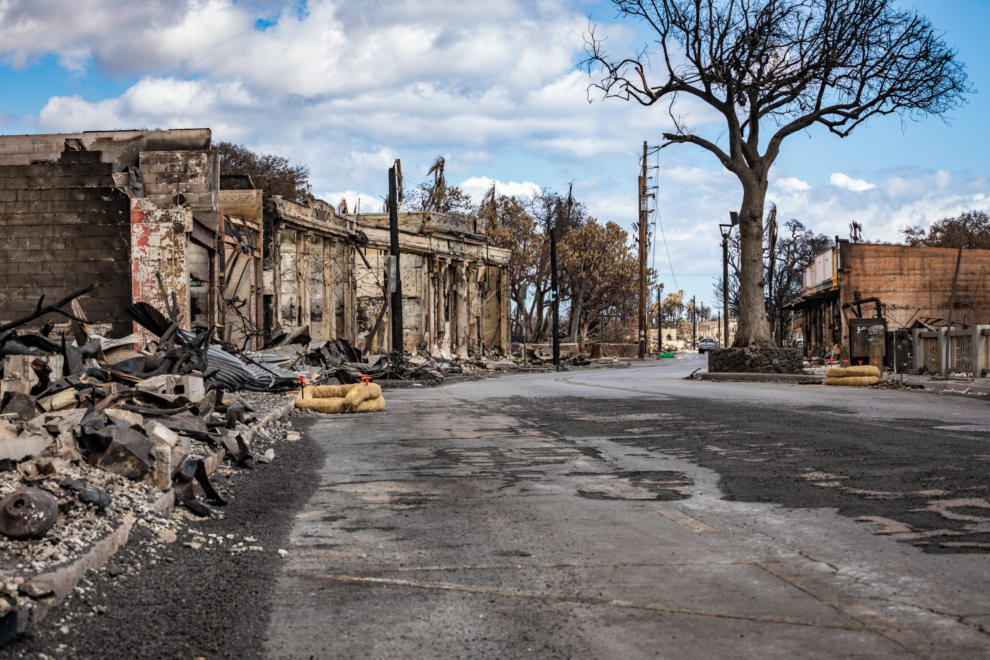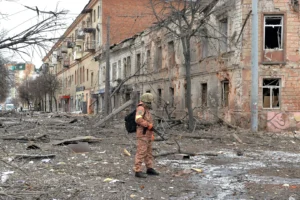The deadly wildfires on Maui could trigger insurance companies to reevaluate the risks associated with offering coverage to homeowners in Hawaii, which has long been considered a relatively stable market compared to other states.
Claims are already pouring in after the deadliest natural disaster in recent U.S. history.
The Aug. 8 blazes did the most destruction in Lahaina, with at least 115 people killed and 2,200 buildings demolished, but residents in Upcountry also suffered heavy damage. Maui County has estimated that it will cost about $5.5 billion to rebuild.
Anticipating the influx, the state issued a declaration the day after the fire temporarily allowing independent adjusters who don’t reside in Hawaii to help process the claims.
“There’s a huge amount of claims being filed,” said Steve Severaid, president of Adjusters International Pacific Northwest, the largest public adjusting firm in the region. “There are various stages of people filing claims to insurance companies that haven’t responded (and) to insurance companies that have responded.”

Numbers are hard to come by, but the state insurance commissioner said one major insurer received 600 wildfire-related claims in the week after the fires. He declined to specify which insurer.
The commissioner, Gordan Ito, last week also issued a memo encouraging insurers to ensure continued coverage for those impacted by the wildfires.
The concern aligns with a national trend of companies increasing rates and limiting coverage — or pulling out altogether — in areas at a high risk of the effects of climate change.
“Wildfires have become more of a concern for every insurance company in a lot of parts of the country, including (Hawaii),” said Jing Ai, a finance, risk management and insurance professor at the University of Hawaii. “And this particular tragic and large-scale event just makes it more urgent for them to reevaluate.”
Ito earlier this month said he wasn’t aware of any insurers planning to pull out of the state because of the fires.
But one company, Universal Property & Casualty announced in July that it’s leaving the state’s homeowners, condominium and renters insurance market because of “limited traction,” and that it “only insured about 1,000 homes,” according to the Hawaii Tribune-Herald. The decision affected about 1,500 policies.
“That is definitely, I think, a possibility that there will be insurers that will reassess the risk of wildfires in Hawaii,” Ito said in an interview.
“I’m hoping that insurers will still stick with the Hawaii market and there wouldn’t be an availability issue like what is occurring in some other states,” Ito said. “Just keeping my fingers crossed.”
Hawaii is in a better position than states like Florida and California, where more insurance companies are pulling out, leaving homeowners with fewer options. Allstate and State Farm are among the companies that won’t be issuing new policies for California homeowners, citing wildfire risk as a reason. Florida, meanwhile, is facing an insurance crisis as companies continue to leave the state.
“Fortunately, Hawaii’s market has been stable for many, many years,” Ito said. “For the most part, whether it’s homeowners, hurricane or motor vehicle, there is still availability, unlike other states.”

A Struggle To Meet Anticipated Demand
Questions over the role of insurance companies always loom over natural disasters amid a need to provide urgent assistance to victims while protecting the bottom line. That delicate balance has been exacerbated by climate change, which is responsible for more intense and more frequent extreme events such as storms, droughts, floods and wildfires.
State Farm has issued a moratorium on writing fire policies in parts of Maui where the wildfires are still actively burning, said Sevag Sarkissian, a public affairs specialist at the Bloomington, Illinois-based company.
“Moratoriums are removed once the fire is fully contained,” Sarkissian wrote in an email on Thursday. It “affects new business (including some policy changes for existing policies) in impacted locations.”
It’s not unusual for insurers to put moratoriums on new policies in place in areas that are experiencing or have recently experienced a natural disaster, according to Janet Ruiz, a spokeswoman for the Insurance Information Institute, an industry association.
“Whenever there’s a catastrophe … insurance companies won’t write new insurance on homes in the middle of it,” Ruiz said.
It’s unclear whether other insurance companies have also issued a moratorium on new policies in the area. First Insurance Co., Allstate and DB Insurance Co. declined to say if they also have issued a moratorium. Liberty Mutual didn’t respond to a request for comment.
On The Ground In Maui
State Farm is the largest homeowners insurer in the state, according to data from the Hawaii Insurance Division. It covers about 35% of the market and has about 162 million premiums written. Allstate is the second-largest insurer, with approximately 8% of the market and 37 million premiums written, according to data from the Hawaii Insurance Division.
First Fire & Casualty Insurance of Hawaii, Liberty Mutual and DB Insurance Co. round out the top five.
Representatives from the state’s Insurance Commission, at least 15 insurance companies and financial institutions were on Maui this past weekend to provide in-person assistance to those looking to file a claim or ask questions about the process during an event at the Whalers Village Parking Lot.
State Farm also has opened a customer care center in Kahului open seven days a week to reach customers.
Public adjusters, meanwhile, have been assisting property owners in filing and preparing their insurance claims and negotiating settlements for a percentage of their client’s final offer from the insurance company. The Adjusters International Pacific Northwest had about five adjusters in the area last week, Severaid said.
Consumers should also be aware of potential scams.
“One of the things that does concern me is folks hiring anyone who is going to take a contingency fee off of their insurance money,” said Jeffrey Foster, a personal injury attorney based on the Big Island. Foster advises homeowners to hire an attorney only in the case of a claim denial, and not to help file an initial claim.
Homeowners should also be skeptical of those who promise discounts for customer referrals, insist on a large deposit or cash payments, ask them to secure their own building permits or do not provide local contact information, Sarkissian said.
One Solution — Strengthening The Safety Net
There also are worries that the state’s property insurance safety net, the Hawaii Property Insurance Association, isn’t equipped to handle an influx of Hawaii homeowners who may no longer be able to get coverage in the coming years as companies reassess their risk.
HPIA was established as a nonprofit in 1991 to provide basic property insurance for residents who’ve been denied coverage in the private market at least twice, but intense demand would likely outstrip the association’s capabilities.
The HPIA generally charges higher rates for less coverage than private companies. The association’s maximum coverage limit is $450,000, which is far less than the average price of a single-family home in the state.
The Insurance Commission approved a price hike in December 2022, which led HPIA to increase monthly coverage rates this year.

The HPIA offers coverage of the direct loss of property caused by fire, lightning, vandalism and malicious mischief, according to the association’s website. However, it doesn’t sell hurricane coverage, even as rising sea surface temperatures continue to cause intense tropical storms. The association did not respond to requests for comment.
Other states also offer options for homeowners who are unable to find insurance in the private market, although some have a higher limit.
California established a FAIR Plan in 1968 to provide access to basic property coverage for those living in areas threatened by wildfire. The maximum limit is $3 million for a FAIR Plan dwelling fire policy in California, over six times higher than the HPIA’s limit.
The HPIA could offer coverage to more people if it were to undergo risk assessment and procure reinsurance to cover any additional risk, Ito said, although the cost of reinsurance has risen over the past few years, partly due to the impact of climate change on the industry.
“It’s not like an overnight thing, but it is possible for them to expand,” Ito said.
Source : CivilBeat











